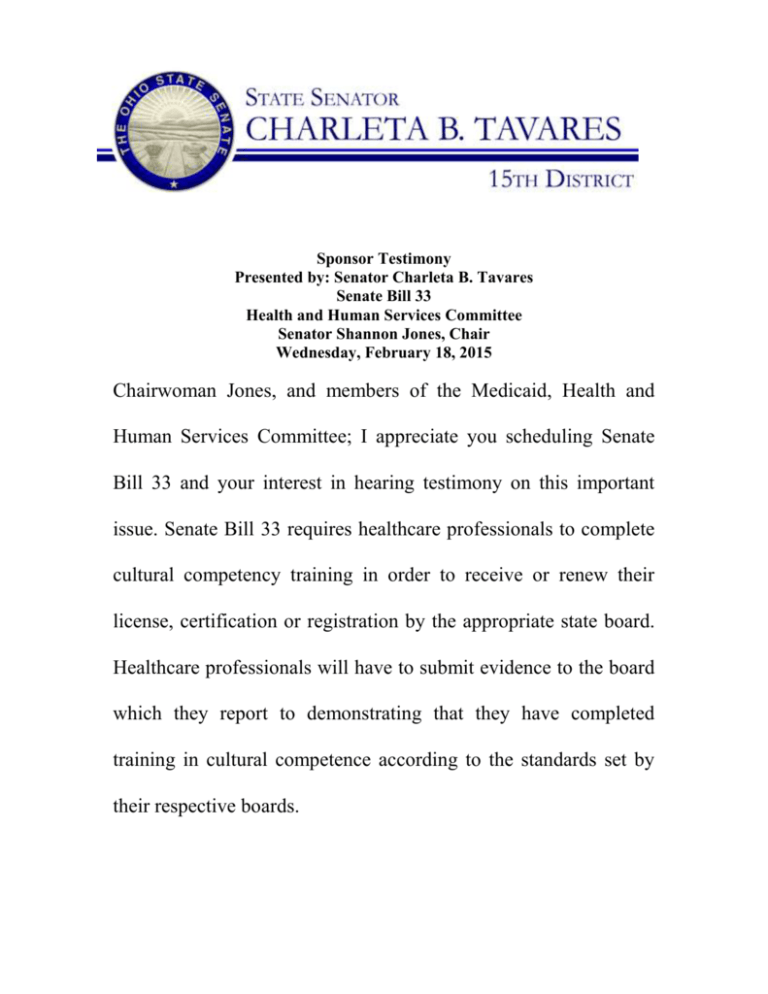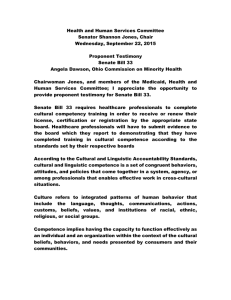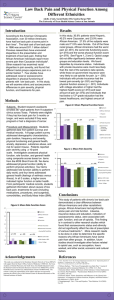Sponsor Testimony Presented by: Senator Charleta B. Tavares
advertisement

Sponsor Testimony Presented by: Senator Charleta B. Tavares Senate Bill 33 Health and Human Services Committee Senator Shannon Jones, Chair Wednesday, February 18, 2015 Chairwoman Jones, and members of the Medicaid, Health and Human Services Committee; I appreciate you scheduling Senate Bill 33 and your interest in hearing testimony on this important issue. Senate Bill 33 requires healthcare professionals to complete cultural competency training in order to receive or renew their license, certification or registration by the appropriate state board. Healthcare professionals will have to submit evidence to the board which they report to demonstrating that they have completed training in cultural competence according to the standards set by their respective boards. According to The U.S. Department of Health and Human Services Office of Minority Affairs, culture is defined as integrated patterns of human behavior that include the language, thoughts, communications, actions, customs, beliefs, values, and institutions of racial, ethnic, religious, or social groups. Competency in serving diverse cultures implies having the capacity to function effectively as an individual and an organization with regards to the cultural beliefs, behaviors and needs presented by consumers and their communities. Cultural Competency has become recognized as an integral component of healthcare because of its relevance in treating patients and eliminating health disparities among racial, ethnic and cultural communities. A significant aspect of communication between the provider and the patient includes conversations and the respect that is demonstrated for their culture, language and beliefs. It is critical that patients and healthcare providers are able to effectively communicate with one another in order for the best care to be provided. Research from the Health Policy Institute of 2 Ohio indicates that African Americans and Hispanics are more likely than Caucasians to feel they have been treated disrespectfully during a health care visit - spoken to rudely, talked down to, or ignored. Compared to Caucasians, African Americans, Hispanics, and Asian Americans are more likely to report that their doctor did not listen to everything they said, they did not fully understand their doctor, or they had questions during the visit that they did not ask. This type of miscommunication can be fatal. Examples of health disparities among racial and ethnic minority populations include following diseases: Cancer The cancer incidence rate among African Americans is 10 percent higher than among whites.i The cancer death rate for African Americans is 35 percent higher than the rate for whites.ii Hispanics have higher rates of cervical, gallbladder, and stomach cancer than whites. In Ohio blacks are 32 percent more likely to die from cancer.iii 3 Cardiovascular Disease Coronary heart disease is more prevalent among African Americans compared with whites and the prevalence among African Americans is rising while the prevalence among whites is falling. In addition, coronary heart disease mortality is higher among African Americans than whites. iv Heart disease is the leading cause of death for all racial and ethnic groups in the United States. v Diabetes/Kidney Disease African Americans and Hispanics are twice as likely as whites to have diabetes.vi The death rate is 27 percent higher for African Americans with diabetes and 40 percent higher for Hispanics, than for whites.vii In Ohio, the death rate among African Americans with diabetes is 2.5 times greater than for whites.viii This data only represents a few of the health complications that are more prevalent among diverse populations in our country and state. 4 What also must be considered is that socioeconomic status, income and education impact cultural norms and behavior. Studies show that these factors are associated with the higher rate of heart disease in minority populations. ix Healthcare providers need to be equipped with the skills to serve the state’s diverse populations which are continuing to increase. In Ohio racial and ethnic minorities represent about 15% of the population.x African Americans account for 12.2 % and Asians 1.7 %.xi The Hispanic population in Ohio grew 40.2% between 2000 and 2008, and now accounts for 3.1 % of the state’s total population.xii In addition, there are regional differences. For example African Americans account for 51% of the population in Cleveland.xiii According to the federal Office of Refugee Resettlement, Columbus is host to the second-largest Somali community. Available estimates for the total Somali population in the county vary however, the population is somewhere between 15,000 – 40,000. Furthermore, with more than 60 languages spoken in Ohio it is increasingly important to be culturally and 5 linguistically competent in order to better serve our state’s residents. To address this issue the U.S. Department of Health and Human Services established the National Standards on Culturally and Linguistically Appropriate Services (CLAS) aimed at assisting healthcare organizations in making their services culturally and linguistically accessible.xiv CLAS themes are separated into the following areas: Culturally Competent Care, Language Access Services and Organizational Supports for Cultural Competence. While some of the standards serve as recommendations and guidelines others are mandated for recipients of Federal funds.xv Five states have required cultural competency as a part of their continuing medical education: California, Connecticut, New Jersey, New Mexico and Washington. In order to achieve health equity we must eliminate barriers that prevent individuals from receiving quality care. Requiring cultural competency training is an opportunity to assist healthcare 6 providers in gaining the knowledge needed to successfully serve patients from all backgrounds and eliminate health disparities among all Ohioans. Chairwoman Jones and members of the Committee, I appreciate your attention to this issue and I respectfully request your favorable consideration and passage of Senate Bill 33. Thank you and I am happy to respond to questions from the committee. i "Understanding Health Disparities." Health Policy Institute of Ohio (2004): 1-32. Web. November 2004. Ibid iii Ibid iv Ibid v Ibid vi Eliminating Racial & Ethnic Health Disparities." Office of Minority Health and Health Disparities . Office of Minority Health and Health Disparities , n.d. Web. 15 Mar 2010. <http://www.cdc.gov/omhd/About/disparities.htm>. vii "Understanding Health Disparities." Health Policy Institute of Ohio (2004): 1-32. Web. November 2004. viii Ibid ix "Eliminating Racial & Ethnic Health Disparities." Office of Minority Health and Health Disparities . Office of Minority Health and Health Disparities , n.d. Web. 15 Mar 2010. <http://www.cdc.gov/omhd/About/disparities.htm>. www.quickfacts.census.gov/qfd/states/39/3918000.html x "City-Data.com." Office of Minority Health and Health Disparities . www.city-data.com, 2010. Web. 15 Mar 2010. <http://www.city-data.com/states/Ohio-Ethnic-groups.html>. xi Ibid xii Ibid xiii Ibid xiv "National Standards on Culturally and Linguistically Appropriate Services (CLAS)." Office of Minority Health. Office of Minority Health, n.d. Web. 18 April 2012. <http://minorityhealth.hhs.gov/templates/browse.aspx?lvl=2&lvlID=15>. xv Ibid ii 7







